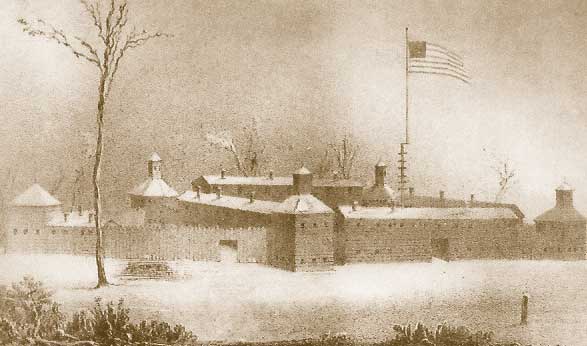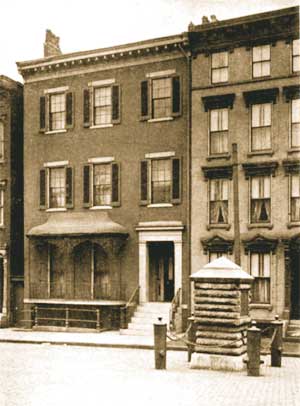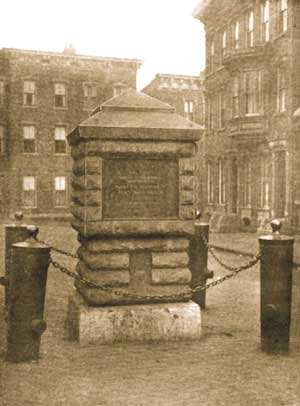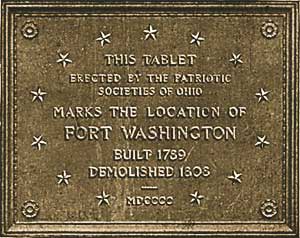In the above painting, it is believed this view would be looking toward the northeast. The larger hill in the background would probably be Mt. Auburn.
Fort Washington
After the Revolutionary War, settlers were increasingly making their way into the Northwest Territory looking for more freedom, or looking for a new start. A number of those settlers began arriving in what is now Cincinnati, but in the 1780s, this was just a convenient stopping point in a long river ride. Already a few settlers had set up small business along the river selling needed supplies and hardware's. But this was not yet a safe place for anyone.
Native Americans had long protested the presence of American settlers moving onto the land north of the Ohio River. Many of the Native Americans in the Ohio Territory sided with the British during the American Revolution in hopes that this alliance would be enough to fend off the advancing Americans. During that war, a major military expedition led by George Rogers Clark moved up from what is now Cincinnati and completely destroyed a Shawnee village near present day Piqua. This would set in motion a series of conflicts between Native Americans and American settlers in the over the next two decades.
 John Symmes
John Symmes
In early 1789, a treaty among a number of Native Americans was agreed to at Marietta. Since the end of the Revolution, American settler's numbers increased dramatically along the Ohio even though the land proved to be a constant struggle between Mother Nature and Native Americans already living in the area.
Fears of conflicts between the settlers and the Native Americans were heightened. Even with the treaty, which many of the Native Americans in western Ohio did not recognize, the conflicts increased. A wealthy landowner, Judge John Symmes, had purchased a large track (400,000 acres) of land along the Ohio River between the Miami and Greater Miami Rivers, to sell off in lots to the new rush of settlers.
Concerned over the Indian attacks that would eventually hurt his land sales, he petitioned the US Congress to do something about the problem and provide protection. That job fell to the senior officer of the United States Army, Josiah Harmar.
 Harmar already had experience building forts in the Ohio Territory. In 1785 he built Fort Harmar near Marietta. He also supervised the construction of Fort Steuben that later became Steubenville. In 1787 Harmar was promoted to Brigadier General.
Harmar already had experience building forts in the Ohio Territory. In 1785 he built Fort Harmar near Marietta. He also supervised the construction of Fort Steuben that later became Steubenville. In 1787 Harmar was promoted to Brigadier General.
It wasn't until the end of the summer of 1789 Harmar built Fort Washington. With Harmar's previous experience, his men constructed the fort unlike any other frontier fortification. Its stone foundation and reinforced walls provided protection from light artillery. Some of the wood used in the flooring of the construction, came from Kentucky boats discarded by pioneers upon completing of their journey down the Ohio River. Harmar joined his men at the fort in December of that year and officially moved his headquarters to the new location. It wasn't until Harmar arrived and seeing the actually fortification, that he sent word to the Secretary of War that he had chosen the name of Fort Washington "on account of its superior excellence" to honor the new president.
The fort was placed above the flood plane about 1000 yards from the river. It was laid out in a rectangular shape facing the river. A two story command post and a well were centered in the fort with additional two story blockhouses on each corner. Triangular extensions were added later to the north and west sides. This sturdy and impressive fortification would see both General Harmar in1790 and General St. Clair in 1791 lead their men into punishing defeats against Chief Little Turtle. In 1791, an 18 year old ensign, William Harrison, arrived at the fort to begin his military career on the frontier. He who would later become president of the United.
It must have been extremely reassuring for new settlers coming down the Ohio River to see Fort Washington high up on the bluffs of the river providing them a sense of relief and protection that they may not have felt since leaving the safety of the east.
In 1794, General Anthony Wayne re-organized the American Army, and began constructing a series of forts extending northward up through western Ohio. These forts would provide the necessary reinforcements to confront the Native Americans. In August of 1794 Wayne launched a decisive engagement at what would become known as the Battle of Fallen Timbers. This battle ended the Indian wars in Ohio and brought about the signing of the Greenville Treaty which laid the ground work for the creation of the state of Ohio.

Above is a sketch made by Major Jonathan Hart in 1791. Hart was stationed at the fort.
As peace spread across the territory Fort Washington was no longer necessary and was abandoned in 1804. The structure of the fort was assimilated into the growing community of Cincinnati and in time the location of this once vital outpost was lost to history. Years later, most historians believed its location to have been near the corners of 3rd and Broadway, so on June 14, 1901 a 9' tall Ohio stone memorial that mimicked one of the old fort's blockhouses, was placed at that location to commemorate Fort Washington.
During the dedication ceremonies in June, the a detachment of the 2nd Regiment took part in the ceremonies. The 2nd Regiment was first organized at Fort Washington in 1791. As the ceremonies drew to a close, 4 buglers of the Regiment played taps as the last tribute to the memory of those that had served at the fort.
The monument was surrounded by a chain railing supported by four old cannon. The face of the monument towards the west carried 2 bronze tablets, the upper one containing the dedicatory inscription. The lower tablet contained an outline map of the main portion of the fort, together with the streets which intersected it or which surrounded the area.


Photos of the original location of the Fort Washington Monument in the middle of Third Street. The monument was erected by the Societies of the Mayflower, Colonial Wars, Colonial Dames, Sons of the Revolution, Sons of the American Revolution, Daughters of the American Revolution, Children of the American Revolution, War of 1812, and the Loyal Legion.
In 1900 there was much effort made to determine the exact location of the old fort. The location of the fort had come into question in the 1829 when lands that had been purchased by officers living in the fort were put into question. Part of the problem was that the fort had multiple blockhouses, and the fort's plans had been forwarded to the War Department where they were destroyed by a fire in 1809. They therefore had to rely on the memories of people about the size and location of the building that had disappeared some 25 years earlier. Part of their determination on the exact location depended up the sketch (shown above) created by Major Jonathan Hart.

So in 1901 it was determined where the fort once stood and great care was taken for the placement of the monument. However, in 1952 during some construction a few blocks away, workers were surprised when they found some of the actual remains of the fort's powder magazine not far from the Taft Museum and Fourth Street.

Archaeologist surveyed the sight and concluded this was the true Fort Washington location. The monument was moved to the new site in 1998 where it can be seen today just south of E. 4th St. on Arch Street. Should you wish to see replicas of the fort and get a better understanding of how it functioned visit the Cincinnati Museum Center located in the Union Terminal complex.
One interesting point is that the original location of the monument is exactly where I-71 now flows. So the question begs to be answered: did they indeed determine the new location because of the excavations, or was the monument moved to make room for progress? Perhaps the answer is both.
Source: Fort Washington at Cincinnati, Ohio by Robert Ralston Jones, 1903



